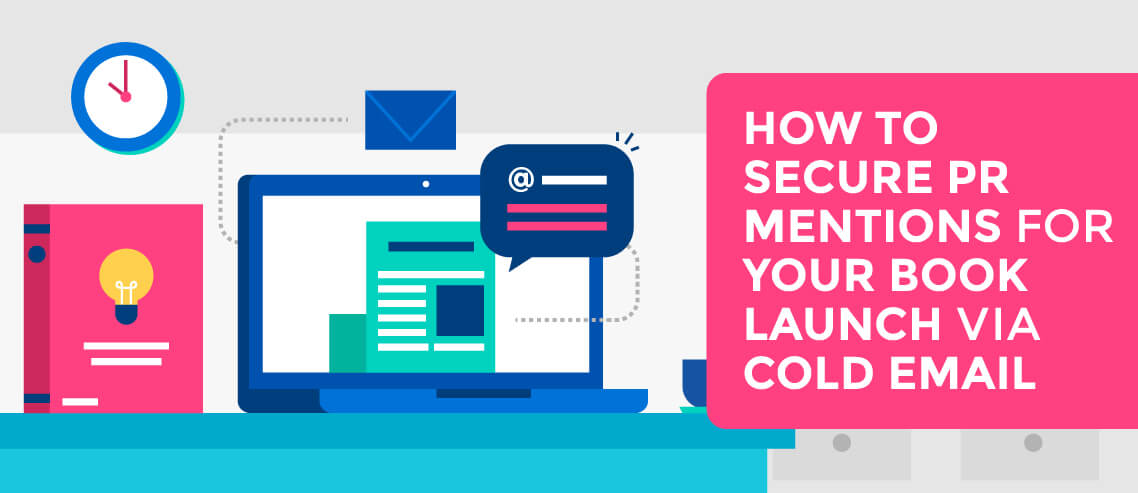How to Secure PR Mentions For Your Book Launch via Cold Email

Contents
Book marketing is a strange, undocumented world. There is a wealth of information on every other part of writing and publishing:
- There are roughly 1 billion services offering writing prompts and courses that will teach you how to write a business book.
- If the actual writing of your book is the issue, you can just hire a ghostwriter from an actual marketplace—not a sketchy forum.
- We have yet to invent a number large enough to quantify the number of books and courses on self-publishing, but suffice to say, your clever 6-year-old niece could publish her book after an hour or so of Googling.
If you have even half of an idea for a book, with roughly one day of research you can learn everything you need in order to write and publish it.
And yet, when it comes to marketing your book, there seems to be very little accessible, useful information available.
Let’s fix that. I’ve used Mailshake to marketing many books successfully, and in this article, I’m going to break down the basic steps to using Mailshake to run a PR campaign for a book.
We’re going to be using a book that I just made up as an example throughout this piece. The book is titled Standing Desk Not Required: A Guide To Taking Your Startup Remote, and it is written for founders who’d like to transition to a remote team.
Let’s begin.
Note: While this article is focused specifically on books, the majority of its advice is applicable to PR in general—so if you work in publicity for an industry other than publishing, read on!
1. Good PR Starts With Good Research
Seriously, I can’t say this enough. Your pitches can be beautiful, your follow up can be flawless, but if you’re pitching the wrong people, you’re going to strike out.
Research is the most time consuming and expensive part of the process, and as a result, many authors and marketers try to find shortcuts. Trust me, cutting corners here will sabotage your campaign.
Let’s start at the very beginning with research. Before you can get fancy your pitches, you need a way to find people to pitch. You have a number of options here, listed in order from most expensive to cheapest:
- Use a PR database like Muck Rack. This is the publishing industry standard. You type in your criteria, and it spits you out a list of media contacts—email addresses and all. It can also cost upwards of $1,000, so not for every budget.
- Hire a research assistant. Using a site like UpWork, you can get an assistant to do your research for a low hourly rate. You still have to manage and monitor here, but at least you aren’t manually sifting through search results.
- Search for yourself. This is the only free option. Do a whole lot of Googling to find relevant media contacts, and even more to find their email addresses. Unless you really have no budget, I would not recommend doing it this way.
Once you’ve decided how you’ll go about collecting your data, you need to figure out how you’re going to organize it.
By organizing your data, I mean deciding the categories of media contacts you want to research. You’re going to have different categories of people, and each group is going to need a different kind of pitch.
In general, these are the categories of media contacts you want for a book launch:
- People who have written about books similar to yours. These are the easiest people to get coverage from. They’ve already written about books like yours, and so shouldn’t be tough to initiate a conversation with.
- People who cover and review books generally. While these people are going to be flooded by competing authors, they are also the least likely to respond poorly to a cold pitch about your book. After all, getting pitched by authors is literally their job.
- Reporters who cover your space generally. It’s rare that someone in this category will write any sort of book review, but offering your book—and more importantly, your expertise—as a primary source can lead to some great mentions in the press.
- Influencers from within your audience. These aren’t typical press people, but they have the ability to move more copies of your book than just about anyone else.
You’ll want to create a separate spreadsheet for each group—just make sure you don’t have duplicates across sheets.
Let’s take a look at how this looks in practice.
To find people who have written books similar to Standing Desks Not Required, we’d start by finding the most popular book on the subject. A quick Amazon books search reveals that this book is Remote by Jason Fried.
Next, we’d search Google for articles about Remote (unless we’re using a PR database, in which case we’ll search the database for articles about Remote):

After collecting a spreadsheet full of these articles, we’d rinse and repeat this process for other popular books in the category, until we had between 30 and 50 articles. Then, either on our own or through a VA, we’d find email addresses for each writer.
Next, we’d want to find people who cover and review books generally. This step is very easy. We can simply Google “business book review” (replace “business” with whatever your niche is), and Google will spit out dozens of results:

We’d add all of these to a separate spreadsheet, and either manually research contact information/submission guidelines, or have a VA do it.
Third on our list, we’d compile a list of journalists who cover our space generally. Here again, Google is our friend.
We’d run a quick Google News search for our topic. For example, here are the top results for “Remote work”:

Again, we’d add these writers to a separate spreadsheet, and research their contact information.
Finally, we’d need to find influencers in our niche—in this case, either digital nomads or entrepreneurs.
We find these people by scouring social media. For example:

Once we found 30-50 people, we’d add them all to a spreadsheet, and research their contact information.
At the end of all of this, we would have between 120 and 200 contacts to pitch. That’s a manageable number to start with, and can always be scaled up if need be.
Pro tip: For each contact, collect any data that you might need to use in a pitch. Names of their recent articles, fun facts from their Twitter bios, anything. A lot of people are hesitant to collect one-off information because it’s hard to use it in a programmatic way, but with Mailshake’s Preview feature (more on that later), you can get a ton of value out information you can’t include in a template.
2. Write Pitches That Don’t Sound Like Robocalls
PR pitches, almost without fail, suck. The crazy part is that unlike most industries where it’s young people making “rookie mistakes,” most of the worst pitches I see come from PR veterans.
This dynamic stems from a phenomenon I call the Ouroboros of Garbage PR.
For those of you who had friends as kids, the Ouroboros is an image of a snake eating its own tail. It represents an infinite, self-perpetuating cycle, and it looks like this:

Here’s how the Ouroboros of Garbage PR works:
- A PR specialist writes a mediocre pitch, and blasts it to 50 journalists.
- Most of the journalists—being inundated by garbage like this all day long—immediately archive the email. Maybe one or two reply out of boredom.
- The PR specialist, being a lazy human, decides the problem is that they didn’t pitch enough journalists, and so they pitch a fresh 100.
- Again, most of the journalists ignore the email. Three or four respond this time.
- Spurred on by their middling success rate, the PR specialist keeps increasing the size of their contact list, until they’re carpet-bombing 1,000s of journalists to get 10 responses.
Be better than Garbage PR. It’s really not hard.
The first step to not running Garbage PR is to understand this simple fact about pitching:
You don’t have to sacrifice quantity for quality in your pitching.
Using Mailshake, you can still email 1,000 journalists quickly—but you can do it with real personalization, not the standard Mailmerge templating.
It all starts with having a killer template for each category of media contact you’ll be pitching. For example, when you pitch people who have written books similar to yours, your template might look like this:
SUB: {{Name}}, have you read this?
BODY:
Hey {{Name}}!
I just read your coverage of {{Book Covered}}, and thought you might be interested in seeing a free copy of my new book, {{Book Name}}.
It’s similar to {{Book Covered}} in that it {{Similarity}}—but {{Book Name}} is different in that it {{Difference}}.
If you’d like to see a copy, let me know and I’ll get one shipped to you ASAP. If you’d prefer a digital copy, just let me know.
Best,
{{Your Name}}
This template isn’t fancy—it gets straight to the point, tells them why what you’re offering is valuable and relevant to them, and makes it easy for them to say yes.
Journalists are here to cover things that interest them. You don’t need to be coy in your pitches. Come out and say what you want, and why they should say yes.
In Mailshake, your pitch will look like this:

This brings us to the second part of not running Garbage PR: follow up.
Follow up is essential. Journalists are super busy people, and need some cajoling to cover your book. What they don’t need, however, is someone spamming their inbox with generic follow up messages.
You want each follow up you send to offer a new piece of value to the journalist. So your first follow up might say something like:
Hey {{Name}}!
I hope your week has treated you well. I’m following up on our last email to see if you had any interest in seeing a free copy of {{Book Name}}—or if that’s not of interest, of interviewing me as a source for any articles you’re writing on {{Topic}}.
Looking forward to talking!
Best,
{{Your Name}}
In this follow-up, you’re offering them a primary source (you) for any article they’re already working on. That’s a value add, and the kind of thing that get an unresponsive journalist talking.
In Mailshake, you can automatically set this follow up to be sent seven days after your initial email—unless you receive a reply first. This allows you to automate your follow up without spamming media contacts who are already speaking to you.
Do this by clicking the “FOLLOW UP” button beneath your initial email in Mailshake, and setting your follow up dates like this:

Once all of this is in place, you can move onto the next step—my favorite Mailshake feature, the Preview.
After you save your templates and click “Next,” Mailshake will take you to the preview screen, where you can flip through every email that is about to be sent and personalize them each rapidly:

You’ll have a chance to replace any broken inserts. You can also quickly add a personal note—meaning all that one-off data you collected about each media contact can be used here to rapidly tweak your pitches.
This is a massive timesaver, as it gives you a real compromise between the efficiency of a mail merge and the effectiveness of personalized pitching.
With all of this done, you will have successfully avoided the Ouroboros of Garbage PR.
Pro Tip: You can use Mailshake’s Sending Calendar to make sure your emails are only sent to your media contacts early in the morning, ensuring your pitch will be the first thing they see when they open their inbox.
3. Automate all your basic interactions
One of the massive time-sucks of PR is the back and forth with journalists—and if you followed the steps above, you’re going to have a lot of journalist responses to deal with.
The majority of these journalists, however, are going to have the same interactions with you. They’re either going to:
- Say no to you.
- Say yes to you.
A small fraction of journalists may have a more complicated question for you, but the majority will either say yes or no.
Instead of combing through your inbox every day, you should automate your basic responses.
It works like this. First, write templates for your most basic and common interactions. For example, if a journalist says no, your template might look like this:
No worries {{Name}}. I really appreciate you getting back to me anyways.
If a journalist says yes and gives you an address, your response might look like this:
Thank you {{Name}}!
Your copy has been shipped. In the meantime, I’ve attached a digital copy and a scan of my media kit to this email.
Let me know if you have any questions!
Best,
{{Your Name}}
Once you have templates in place, you can hire a VA for a low hourly rate to dedicate 1 hour a day to clearing your inbox, marking any emails that require a personal interaction from you, and updating a spreadsheet containing the books you need to mail.
That way, you can spend all of your time focused on interactions with the press that require your personal touch, instead of wasting time and energy on routine emails.
Pro tip: Keep one giant tracking spreadsheet that includes every media contact, their category, the date you pitched them, and their response. Have your VA update this as they run your inbox, so that you can tell at a glance how successful your campaign has been.
4. Your final email is where you win your coverage
At this point, you should have run an effective campaign that ended with dozens of media contacts and influencers receiving a copy of your book in the mail.
This is where so many book marketing campaigns die. You research like a boss, you send great pitches, you mail out copies of your book, and…
…
That’s it.
You know everyone received a copy of your book, but no one is covering it. Many authors take this as a sign that their book just wasn’t that good, and give up here.
That is the complete wrong instinct.
What you need to do now is send a final email that spurs your contacts to action. Something like:
Hey {{Name!}}
I just wanted to reach out and make sure you received your copy of {{Book Name}}.
If you’re interested in covering it, I’d be happy to hop on a call and answer any questions you may have.
If not, just let me know and I’ll stop bothering you about it.
Best,
{{Your Name}}
Again, nothing fancy or coy. Journalists see more pitches in a day than you will in a lifetime—you’re not going to pull anything too clever with them.
But what this pitch does is prod them into action by giving them an easy next step.
Pro Tip: You can get a list of all journalists who have responded by selecting your campaign in Mailshake, clicking “Recipients,” and filtering by those who have replied to you.
Once that email is sent out, you will start to see the fruits of your labor. The journalists who want to cover you will get back you with a yes, and the ones who don’t will get back to you with something nearly as valuable—a “no.”
Which brings me to the final piece of effective book PR…
“No” Is The Second Best Thing You Can Hear
Hearing “No” disheartens a lot of people, but if you want to succeed in PR, “No” has to excite you.
The worst thing that can happen with a pitch is that the other person simply doesn’t respond. All your energy is spent for absolutely nothing in that case.
But when someone says no, they’ve opened the door to a further conversation. They may not cover your book directly, but now that they’ve engaged you, you can say something like:
Thanks for getting back to me! I completely understand—no worries at all.
If you don’t mind me asking, what topics would be more interesting to you in the future? I want to make sure that I only ever reach out to you with ideas that are valuable to you.
And once they send back the topics they want to hear more about, you’ve been given permission to pitch them in the future. Not a bad consolation prize.
At its core, that’s the secret to all good PR strategies. They’re not about getting your message in front as many media people as possible, it’s about identifying the people in the public sphere—journalists, editors, broadcasters, influencers, etc—who could create the most value for you, and figuring out how you can create the most value for them.





